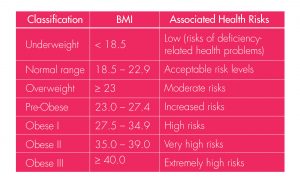Understanding Obesity and Related Terms
Obesity is one of the most pervasive, chronic diseases in need of new strategies for medical treatment and prevention.
As a leading cause of mortality, morbidity, disability, healthcare utilisation and healthcare costs, the high prevalence of obesity continues to strain every healthcare system. It is caused as a result of deposition of excess adipose tissue, which is determined by measuring the Body Mass Index. Significantly, excess adiposity or obesity causes increased levels of circulating fatty acids and inflammation, leading to insulin resistance, resulting in type 2 diabetes. Obesity has been linked heavily to food and lifestyle habits. The biology of food intake is very complex, involving smell, taste, texture, temperature, emotional and metabolic responses, which signal the brain to initiate or cease eating.
Obesity is a disease that affects a majority of the world population and the numbers of people with obesity have been increasing significantly, a trend that shows no sign of reversing. Obesity puts individuals at risk for more than 30 chronic health conditions, to name a few of the deadliest and most common, type 2 diabetes, high cholesterol, hypertension, gallstones, heart disease, fatty liver disease, sleep apnea, GERD, stress incontinence, heart failure, degenerative joint disease, birth defects, miscarriages, asthma and other respiratory conditions, and numerous cancers.
What Is BMI?
Body Mass Index (BMI) is a mathematical calculation involving height and weight, irrespective of family history, gender, age or race. BMI is calculated by dividing a person’s body weight in kilograms by their height in meters squared
BMI = Weight (kg) ÷ Height2 (m2)

This information can be misleading, however, for very muscular people, or for pregnant or lactating women. BMI is frequently used in population studies because of its ease of determination and well-supported association with mortality and health effects. However, other measures of excess adipose tissue, such as waist circumference, waist-to-hip ratio and others are also used. Individuals may need to use additional factors to assess their individual risk including family history, level of physical activity, smoking and dietary habits.
Waist Circumference
Waist circumference is another widely used measurement to determine abdominal fat content. An excess of abdominal fat, when out of proportion to total body fat, is considered a predictor of risk factors related to obesity. Men with a waist measurement exceeding 40 inches are considered at risk. Women are at risk with a waist measurement of 35 inches or greater.
Waist to Hip Ratio
Waist-to-hip ratio (WHR) is a measurement that measures the ratio of waist circumference to that of the hip. It determines how much fat is stored on your waist, hips, and buttocks. Not all excess weight is the same when it comes to your health risks. People who carry more weight around their midsection (an apple-shaped body) are at higher risk for obesity related health risks than those who carry more of their weight in their hips and thighs (a pear-shaped body). According to the World Health Organization (WHO), a healthy WHR is 0.9 or less in men and 0.85 or less for women.
Waist-to-hip ratio chart

Cause of Obesity
There could be many causes for the development of obesity. But the main fundamental cause is an energy imbalance between calories consumed and spent. Globally, there has been an increased intake of energy-dense foods that are high in fat, and an increase in physical inactivity due to the increasingly sedentary nature of many forms of work, changing modes of transportation, and increasing urbanization. Changes in dietary and physical activity patterns are often the result of environmental and societal changes.
Statistics
Overweight and obesity are the fifth leading risk for global deaths. At least 2.8 million adults die each year as a result of being overweight or obese. In addition, 44% of the diabetes burden, 23% of the ischaemic heart disease burden and between 7% and 41% of certain cancer burdens are attributable to overweight and obesity. Some WHO global estimates from 2008 indicate that:
- More than 1.4 billion adults, 20 and older, were overweight.
- Of these overweight adults, over 200 million men and nearly 300 million women were obese.
- Overall, more than 10% of the world’s adult population was obese.
Once considered a high-income country problem, overweight and obesity are now on the rise in low- and middle-income countries, particularly in urban settings. Overweight and obesity are linked to more deaths worldwide than underweight. For example, 65% of the world’s population lives in countries where overweight and obesity kill more people than underweight (this includes all high-income and most middle-income countries).
Malaysia is not far away from these numbers. A national health and morbidity survey shows that obesity is prevalent among Malaysians above 18, with the numbers drastically rising. The number of obesity cases in 1996 was 4.4% (of the population), rising to 14% in 2006. “This rose to 15.1% in 2011 and 17.7% in 2016. About 30.3% of adults suffered weight problems. As a whole, one in two Malaysian adults is overweight or one in five is obese.
Prevention and Future Outlook for Obesity
Overweight and obesity, as well as their related non-communicable diseases, are largely preventable. Supportive environments and communities are fundamental in shaping people’s choices, making the healthier choice of food and regular physical activity the most affordable and viable choice for preventing obesity.
At the individual level, people can:
- limit energy intake from total fats and sugars,
- increase consumption of fruit and vegetables, as well as legumes, whole grains and nuts,
- engage in regular physical activity (60 minutes a day for children and 150 minutes per week for adults).
- individual responsibility can only have its full effect where people have access to a healthy lifestyle.
Therefore, at the societal level it is important to:
- support individuals in following the recommendations above, through sustained societal commitment,
- the collaboration of many public and private stakeholders,
- make regular physical activity and healthier dietary choices available, affordable and easily accessible to all – especially the poorest individuals.
The food industry can play a significant role in promoting healthy diets by:
- reducing the fat, sugar and salt content of processed foods,
- ensuring that healthy and nutritious choices are available and affordable to all consumers,
- practicing responsible marketing especially those aimed at children and teenagers,
- ensuring the availability of healthy food choices and supporting regular physical activity practice in the workplace.
References:
1) Eric A.F et. al.; Annual Medical Spending Attributable to Obesity – Payer and Service Specific Estimates; Health Affairs 28, No. 5; 2009: 822 – 831; accessed Aug. 2017.
2) Obesity Facts and Figures; European Association for the Study of Obesity; accessed Aug. 2017.
3) Malaysia Clinical Practice Guidelines on Management of Obesity; 2004; accessed Aug. 2017.
 Abraham Mathew Saji is a pharmacist by qualification, engaged in research and development of medicines and their implications on the human body. He is an avid reader in pursuit of knowledge and understanding of technological advancements in the medical and pharmaceutical world. He is even more passionate about sharing his acquired knowledge, which he does by speaking at conferences, lectures and writing. He can be contacted at maz31abr@gmail.com for any clarification.
Abraham Mathew Saji is a pharmacist by qualification, engaged in research and development of medicines and their implications on the human body. He is an avid reader in pursuit of knowledge and understanding of technological advancements in the medical and pharmaceutical world. He is even more passionate about sharing his acquired knowledge, which he does by speaking at conferences, lectures and writing. He can be contacted at maz31abr@gmail.com for any clarification.


